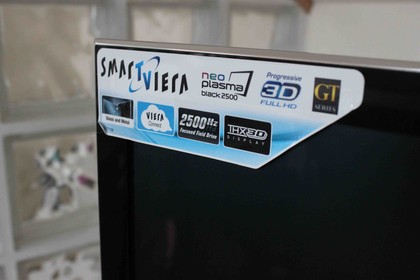Why you can trust TechRadar
The only difference between this plasma and those either side of it in Panasonic's ranges is black levels. On the Panasonic TX-P50GT50, its Infinite Black Filter provides black levels – which contribute immensely to contrast and the boldness of colour – superior to most plasmas.
The way the Panasonic TX-P50GT50 handles 3D, too, is nothing short of amazing. With a pair of the brand's TY-ER3D4ME 3D specs strapped on (though we also managed to use some of Samsung's newest 3D glasses), we watched the entire Hugo movie on 3D Blu-ray.
Totally absorbing, highly detailed and with stunning colours and contrast, we noticed 3D crosstalk on only one occasion. As Hugo Cabret sits down in his chair opposite the automaton, his right leg appeared twice. That was it.

Incidentally, the opening long-shot of snowflakes fluttering across the camera as a panoramic shot screws down into Gare Montparnasse and across the platforms, provided us with the finest views of the 3D format yet – it was almost beautiful in its depth, detail and extreme clarity.
A tad brighter than in previous years in 3D mode, this Panasonic plasma nevertheless excels in a blackout, which will make some shoppers quickly turn to LCD/LED TVs. We're still not sure why brighter equals better to some eyes on the shop floor, because for us a good plasma such as the Panasonic TX-P50GT50 isn't just bright enough for a living room – it's spot-on.
That said, our favourite mode – THX Cinema – is perhaps a tad muted for watching Antiques Roadshow in a brightly lit room. A brighter Living Room mode is cleverly supplied on the Panasonic TX-P50GT50, and though it does make a difference, it's fairly slight.

Talking of brightness, we didn't get on too well with C.A.T.S either. It cleverly alters the brightness of the panel according to the amount of ambient light in the room, but like the Panasonic TX-P50GT50's picture parameter bars, it only manages this in rather clumsy steps – cue a massive drop in brightness a second or two into a new frame of video.
Sign up for breaking news, reviews, opinion, top tech deals, and more.
Until C.A.T.S can happen so gradually as to be unnoticeable, it's always going to be distracting, though it's a purely optional feature.
Switched on by default, Pixel Orbiter in the Picture menu's Advanced Settings menu dampens screen burn (by moving the image around the screen by a few pixels either side – it's unnoticeable), though it's worth engaging the Scrolling Bar feature occasionally, too, since after we'd watched Hugo we did see an after-image of the credit roll.

This was only noticeable in a blackout and had disappeared by morning; we'd judge it as something people may find distasteful, rather than being a problem, though it's worth knowing about.
Switch to Ironclad on 2D Blu-ray and the Panasonic TX-P50GT50 quickly gets back onto its podium. Even in mixed brightness shots black is just that, shadow detail is excellent and the delicate colours are superbly natural and rich. The detail is perhaps a whisper beneath that achieved by a similar-sized LED/LCD telly, but the difference here is that almost all of it remains during motion shots.
For some reason this TV includes the Intelligent Frame Creation feature designed to give LCD/LED panels a helping hand; here it's a weak, almost worthless addition that merely swaps a filmic feeling for a TV/video look, though it doesn't appear to introduce any artefacts.
Freeview HD is clean, bright and looks sublime, while even ropey standard definition channels excel. Some footage from Heir Hunters on BBC1 appears free from digital blocking, and though soft on such a massive screen with some contouring, is overall remarkably clean and free of jagged edges.

Jamie is a freelance tech, travel and space journalist based in the UK. He’s been writing regularly for Techradar since it was launched in 2008 and also writes regularly for Forbes, The Telegraph, the South China Morning Post, Sky & Telescope and the Sky At Night magazine as well as other Future titles T3, Digital Camera World, All About Space and Space.com. He also edits two of his own websites, TravGear.com and WhenIsTheNextEclipse.com that reflect his obsession with travel gear and solar eclipse travel. He is the author of A Stargazing Program For Beginners (Springer, 2015),
